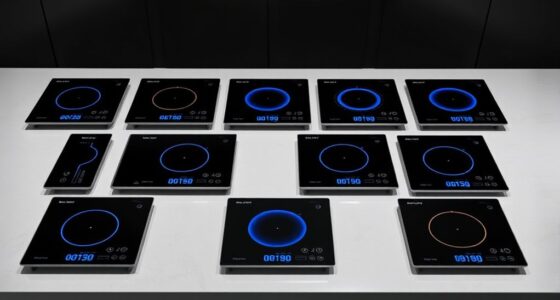If you’re looking for the best wall-mounted hydrogen detector alarms, I recommend considering options with high-precision Swiss-imported sensors, reliable alarm systems, and easy remote calibration. Features like adjustable alarm thresholds, multiple signal outputs, and sturdy, explosion-proof designs guarantee safety in hazardous environments. I’ve identified top models that excel in accuracy, durability, and ease of use. Keep exploring further, and you’ll find detailed insights to help you choose the perfect detector for your needs.
Key Takeaways
- High-precision Swiss-imported electrochemical sensors ensure reliable and accurate hydrogen detection with 1ppm resolution.
- Multiple output options like 4-20mA and RS485 facilitate seamless integration into safety systems.
- Remote calibration via infrared remote control simplifies maintenance and ensures consistent accuracy.
- Compact, wall-mounted design suits space-constrained environments in industrial and hazardous settings.
- Explosion-proof and IP65-rated models provide durability and safety in harsh, demanding conditions.
HCN Gas Detector with Sound & Light Alarm
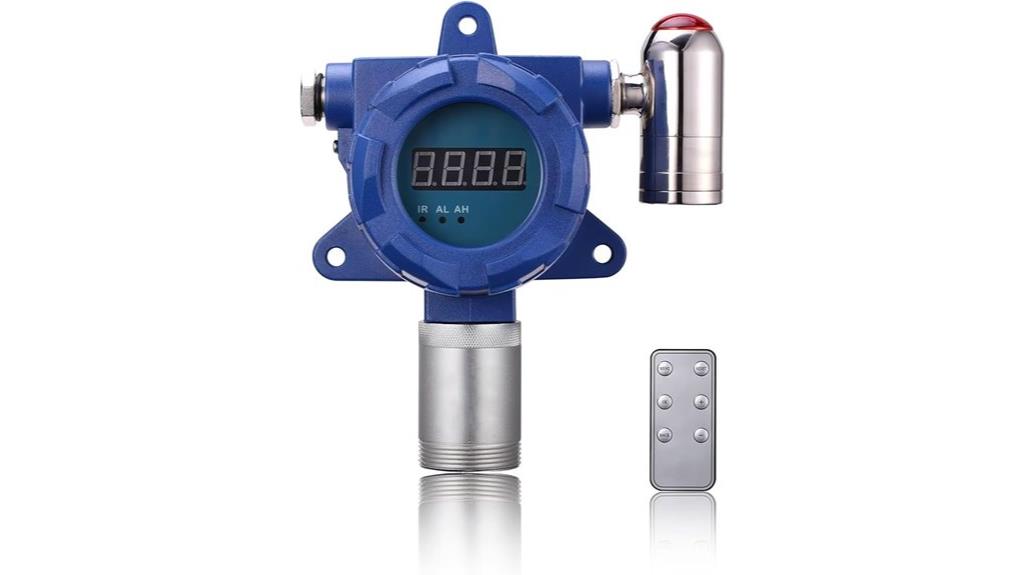
If you’re looking for a reliable way to monitor hydrogen cyanide levels in industrial or pipeline environments, the HCN Gas Detector with Sound & Light Alarm is an excellent choice. I appreciate its precise measurement range of 0-100ppm with 0.1ppm resolution, ensuring accurate detection. The detector’s electrochemical sensors from Switzerland provide dependable readings, while the sound and light alarms trigger immediate alerts. Its full auto-calibration and zero calibration features maintain consistent accuracy. Plus, the infrared remote control makes setting alarm points and calibration easy without opening the cover. This wall-mounted device delivers reliable safety monitoring for critical environments.
Best For: industrial safety professionals and pipeline operators seeking accurate hydrogen cyanide monitoring with reliable alarms and easy calibration.
Pros:
- Precise detection range of 0-100ppm with 0.1ppm resolution for accurate monitoring
- Swiss-imported electrochemical sensors ensure dependable readings
- Features sound and light alarms along with full auto-calibration and zero calibration for maintenance ease
Cons:
- Power source details are not specified, which may require additional setup information
- Wall-mounted design may limit portability for some users
- Requires sign-in on Amazon for feedback and inquiries, which could be inconvenient for some customers
GOYOJO H2S Monitor, Hydrogen Sulfide Gas Detector
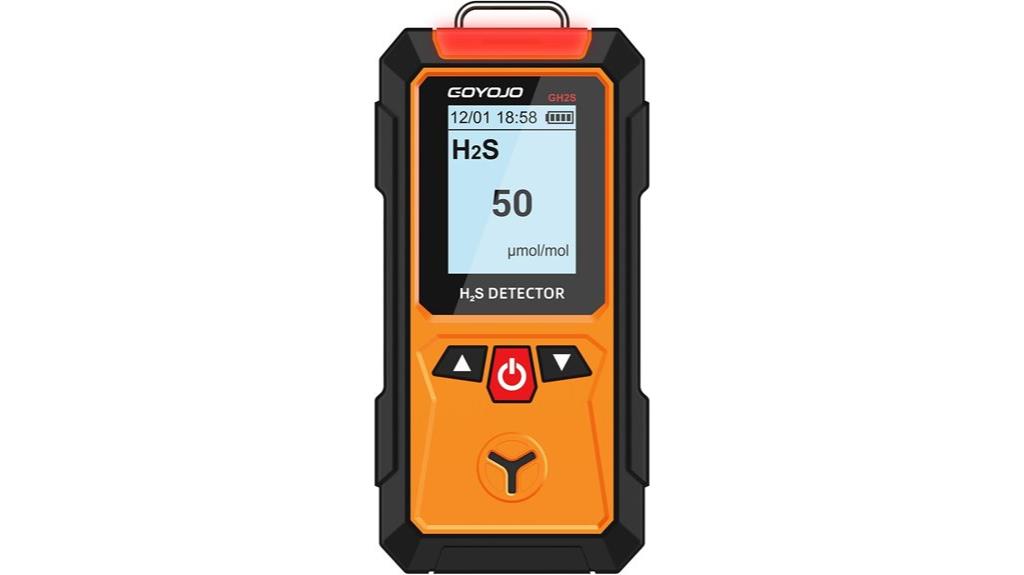
The GOYOJO H2S Monitor is an excellent choice for industries and facilities that require precise, reliable detection of hydrogen sulfide gas, especially in environments where early warning can prevent serious health and safety hazards. It detects H₂S within a 0-100 ppm range, with 1 ppm resolution, allowing for early identification of low-level leaks. The device features audible and visual alarms that activate within 30 seconds, ensuring quick response times. Its user-friendly LCD display shows real-time gas levels and alerts, while the rechargeable USB-powered battery supports continuous operation. Suitable for diverse settings, it offers reliable, eco-friendly protection with lifetime support from GOYOJO.
Best For: industrial, commercial, and residential environments that require early detection and reliable monitoring of hydrogen sulfide gas to prevent health and safety hazards.
Pros:
- Highly sensitive detection with 1 ppm resolution within a 0-100 ppm range
- Rapid alarm activation within 30 seconds for quick response
- Eco-friendly rechargeable battery with USB charging for continuous operation
Cons:
- Limited detection range up to 100 ppm, not suitable for extremely high concentrations
- Requires regular calibration and maintenance for optimal accuracy
- May be less effective in environments with high humidity or dust without proper protection
Wall-Mounted Hydrogen Peroxide Gas Detector with Audible & Visual Alarm

For environments where quick, reliable detection of hydrogen peroxide is essential, the Wall-Mounted Hydrogen Peroxide Gas Detector with Audible & Visual Alarm stands out as an ideal choice. Its Swiss-imported sensors deliver high accuracy within a measurement range of 0-50ppm and a resolution of 0.01ppm. Compact and lightweight, it fits seamlessly into monitoring setups for environments or pipelines. It features both audible and visual alarms that can be remotely configured, ensuring immediate alerts. With full auto-calibration and zero calibration functions, it maintains precise detection over time. Designed for reliable safety, this detector provides peace of mind in environments where hydrogen peroxide monitoring is critical.
Best For: facilities requiring precise and reliable hydrogen peroxide gas monitoring, such as laboratories, manufacturing plants, and pipeline environments.
Pros:
- High accuracy with Swiss-imported sensors and auto-calibration features.
- Compact, lightweight design suitable for various monitoring setups.
- Remote alarm configuration enhances safety and ease of use.
Cons:
- Requires electrical power source for operation.
- May need technical knowledge for initial setup and calibration.
- Limited measurement range (0-50ppm) may not cover extremely high concentrations.
Fixed H2 Gas Detector with 0-5000ppm Range and Remote Monitoring

A fixed hydrogen gas detector with a 0-2000ppm range and remote monitoring capabilities is ideal for environments demanding high-precision gas detection and easy remote management. I appreciate its Swiss-imported sensors, which guarantee accurate readings with 1ppm resolution. The infrared remote control simplifies setup, calibration, and alarm adjustments without opening the unit. It features both 4-20mA analog and RS485 digital outputs for seamless integration into monitoring systems. Its compact size, wall-mount design, and reliable calibration functions make it perfect for pipelines or confined spaces. Overall, this detector offers precise, remote-controlled hydrogen monitoring, enhancing safety and operational efficiency.
Best For: facilities and industries requiring precise, remote hydrogen gas detection in pipelines, confined spaces, or environments demanding high accuracy and easy calibration.
Pros:
- High accuracy with Swiss-imported sensors and 1ppm resolution
- Supports remote monitoring and non-open cover calibration via infrared remote control
- Dual outputs (4-20mA and RS485) for seamless integration into monitoring systems
Cons:
- Limited to a measurement range up to 2000ppm, which may not cover higher concentration needs
- Compact size may limit ease of handling during installation or maintenance
- Requires electrical power, which may necessitate additional wiring in some setups
Wall-Mounted Hydrogen Gas Detector (H2, 0-5000ppm)

If you’re seeking a reliable solution for detecting hydrogen gas in industrial or laboratory settings, the Wall-Mounted Hydrogen Gas Detector with a 0-5000ppm range is an excellent choice. It uses high-precision Swiss-imported sensors to guarantee accurate detection within 0-2000ppm, providing dependable safety monitoring. The device features a 4-20mA analog output and RS485 interface for seamless integration into control systems. It also offers remote calibration and configuration via infrared, simplifying maintenance. Designed for ease of use, it effectively monitors hydrogen levels in environments or pipelines, making it ideal for petrochemical, medical, and chemical waste applications.
Best For: industries and laboratories requiring accurate hydrogen gas detection and reliable safety monitoring within petrochemical, medical, or chemical waste environments.
Pros:
- High precision Swiss-imported sensors ensure accurate detection within 0-2000ppm range.
- Flexible communication options including 4-20mA and RS485 for easy integration.
- Remote calibration and configuration via infrared make maintenance straightforward and efficient.
Cons:
- Limited to a maximum of 5000ppm, which may not be suitable for extremely high gas concentration environments.
- Requires external power supply and proper installation for optimal performance.
- May involve initial setup complexity for users unfamiliar with industrial gas detection systems.
Wall-Mounted Hydrogen Chloride Gas Detector (HCl Monitor)

The Wall-Mounted Hydrogen Chloride Gas Detector (HCl Monitor) stands out as an ideal choice for environments requiring reliable, real-time detection of hazardous HCl gas, especially in industrial settings with harsh conditions. Its measurement range of 0-20ppm and high accuracy ensure precise monitoring, thanks to Swiss-imported electrochemical sensors. The explosion-proof design (Ex d II CT6) and IP65 protection make it durable in tough environments. With quick response times (≤60 seconds) and remote signal outputs like 4-20mA and RS485, it integrates seamlessly into control systems. Its compact size, easy calibration, and remote control features make safety management straightforward and dependable.
Best For: industries and facilities that require reliable, real-time detection of hydrogen chloride gas in harsh or hazardous environments to ensure safety and regulatory compliance.
Pros:
- High-precision detection with a measurement range of 0-20ppm and Swiss-imported electrochemical sensors for reliability
- Explosion-proof design (Ex d II CT6) and IP65 protection suitable for tough industrial conditions
- Easy calibration and remote monitoring capabilities via digital signals and infrared remote control
Cons:
- Limited detection range up to 20ppm, which may not be sufficient for environments with higher HCl concentrations
- Requires a power supply of 12-24V DC, possibly necessitating additional power infrastructure
- Size and weight (180×150×90mm, ≤1.6kg) may be less suitable for very compact or space-constrained installations
H2S Monitor Clip-on, Portable Hydrogen Sulfide Gas Detector

Designed for industrial professionals who need reliable, on-the-go hydrogen sulfide detection, the H2S Monitor Clip-on offers portability and precision in a compact package. Made from durable, explosion-proof ABS plastic, it’s fall-resistant, waterproof, and dustproof, perfect for confined spaces. Its bright LCD display provides real-time gas readings, while a micro-USB port keeps it charged for over 8 hours of continuous use. The electrochemical sensor guarantees high accuracy, with quick response times and customizable alarm thresholds. Easy to mount with clips or hangers, it’s praised for its solid build, ease of operation, and reliable detection—making it a valuable safety tool in demanding environments.
Best For: industrial professionals and safety personnel needing portable, reliable hydrogen sulfide detection in confined or outdoor environments.
Pros:
- Durable, explosion-proof ABS plastic construction ensures safety and longevity.
- Bright LCD display provides clear, real-time gas readings in various lighting conditions.
- Long-lasting rechargeable battery offers over 8 hours of continuous operation with easy USB charging.
Cons:
- Micro-USB charging port may be less convenient compared to newer USB-C options.
- Limited to single gas detection, which might require multiple units for diverse gas monitoring.
- Calibration and maintenance may require additional technical knowledge or support.
Fixed H2 Gas Detector with Sound & Light Alarm, Wall Mounted, 0-5000ppm

This wall-mounted hydrogen detector is an excellent choice for facilities that require reliable, continuous monitoring of hydrogen levels up to 5000ppm. It features a precise measurement range with 1ppm resolution, guaranteeing accurate detection. Powered by batteries, it’s easy to install and integrates seamlessly with existing systems through 4-20mA and RS485 outputs. The device includes sound and light alarms, providing immediate alerts. Its Swiss-imported sensors guarantee high accuracy, while infrared remote control allows simple calibration and configuration without opening the cover. Full auto-calibration and zero calibration ensure consistent, dependable performance for safety-critical environments.
Best For: facilities and industries that require continuous, reliable monitoring of hydrogen gas levels for safety and compliance.
Pros:
- Accurate detection with a 1ppm resolution within a 0-5000ppm range.
- Easy installation and operation thanks to battery power and infrared remote control for calibration.
- Seamless integration with monitoring systems via 4-20mA and RS485 outputs.
Cons:
- Limited to hydrogen gas detection only, not suitable for multi-gas environments.
- Requires regular calibration to maintain accuracy, which may need technical knowledge.
- Battery-powered operation may necessitate periodic battery replacement or maintenance.
Fixed HCL Gas Detector with Sound & Light Alarm
https://m.media-amazon.com/images/I/61QVym5D5rL._AC_SY879_.jpg
If you’re looking for a reliable way to monitor hydrogen chloride (HCl) gas levels in safety-critical environments, the Fixed HCL Gas Detector with Sound & Light Alarm is an excellent choice. It measures HCl concentrations from 0-100ppm with high accuracy, thanks to Swiss-imported sensors. The detector features audible alarms and flashing lights to alert personnel immediately. It’s designed for wall mounting and easy operation, with remote control options for setting alarm points, zero calibration, and address modifications without opening the cover. Full auto-calibration guarantees consistent accuracy, making this detector ideal for environmental monitoring and pipeline safety.
Best For: safety managers and environmental monitoring professionals seeking a reliable, easy-to-use hydrogen chloride gas detection solution with remote calibration capabilities.
Pros:
- High-precision detection of HCl gas from 0-100ppm with 0.01ppm resolution.
- Easy wall-mounted installation with remote control for calibration and alarm settings.
- Reliable Swiss-imported sensors and full auto-calibration ensure consistent accuracy.
Cons:
- Power source details are not specified, which may affect installation planning.
- Limited to HCl gas detection; not suitable for other gases without additional equipment.
- The product weight and dimensions may require sturdy mounting surfaces for secure installation.
Wall-Mounted HCN Gas Detector with 0-50ppm Range

Are you seeking a reliable solution to monitor hydrogen cyanide (HCN) levels accurately in your facility? The Wall-Mounted HCN Gas Detector with a 0-50ppm range offers precise detection using Swiss-imported sensors known for their high accuracy and dependability. It provides a measurement resolution of 0.01ppm and features both analogue (4-20mA) and digital (RS485) outputs for seamless integration. The detector includes an infrared remote control for easy calibration and alarm adjustments without opening the cover. Its auto-calibration functions ensure continuous reliable monitoring, making it ideal for detecting HCN concentrations in environments or pipelines.
Best For: facilities and industries requiring precise monitoring of hydrogen cyanide (HCN) levels in environments or pipeline systems.
Pros:
- High accuracy and reliability due to Swiss-imported sensors with 0.01ppm resolution
- Multiple signal outputs (4-20mA and RS485) for flexible integration
- Easy calibration and adjustments with infrared remote control and auto-calibration features
Cons:
- May require technical expertise for initial setup and calibration
- Potential higher cost due to advanced sensors and features
- Limited detection range (0-50ppm) may not suit applications needing broader measurement spans
H2 Gas Detector with Sound & Light Alarm

The H2 Gas Detector with Sound & Light Alarm is an ideal choice for environments where quick, reliable detection of hydrogen leaks is critical. It’s wall-mounted and features a high-accuracy Swiss-imported sensor that measures hydrogen concentrations from 0 to 2000ppm with 1ppm resolution. The device includes a loud alarm and flashing light to alert occupants immediately. It offers versatile signal outputs, including 4-20mA and RS485, for integration into control systems. Plus, remote control via infrared allows easy calibration and alarm adjustments without opening the cover. This combination of precision, ease of use, and safety makes it an essential tool for hydrogen monitoring.
Best For: facilities and industries that require quick, accurate detection of hydrogen leaks to ensure safety and environmental compliance.
Pros:
- High-precision Swiss-imported sensor with 1ppm resolution for reliable detection
- Versatile output options including 4-20mA and RS485 for easy system integration
- Remote control capabilities for calibration and configuration without opening the device cover
Cons:
- Wall-mounted installation may limit placement flexibility in some settings
- Requires power source for operation, possibly adding to setup complexity
- May necessitate trained personnel for calibration and maintenance to ensure optimal performance
HCN Gas Detector with Sound & Light Alarm
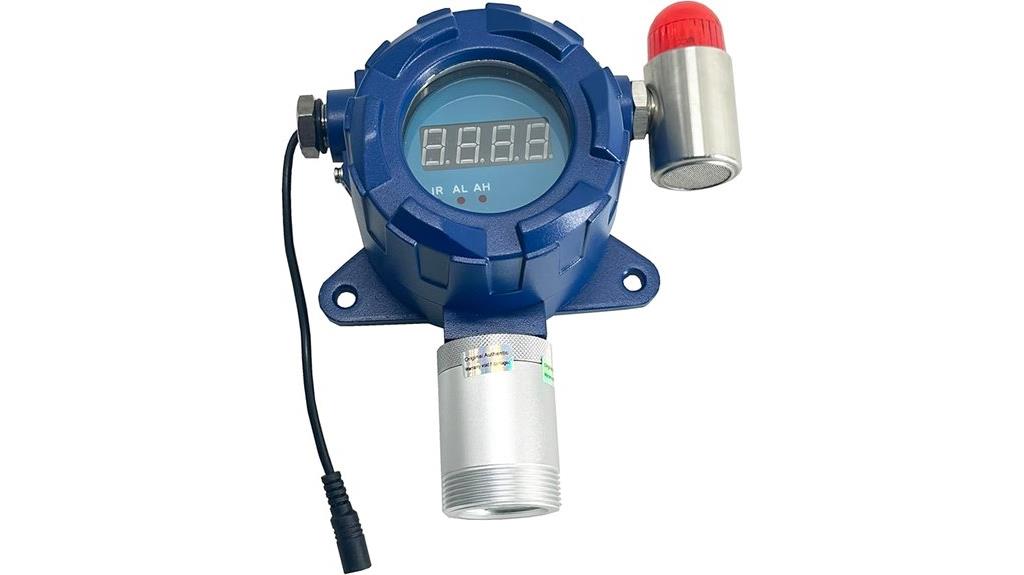
Looking for a reliable way to monitor hydrogen cyanide (HCN) levels in your facility? The HCN Gas Detector with Sound & Light Alarm offers precise, continuous detection within a 0-100ppm range, with 0.1ppm resolution. It’s wall-mounted and uses Swiss-imported sensors for high accuracy and dependability. The device features both sound and light alarms for immediate alerts. Easy to integrate, it provides standard 4-20mA and RS485 outputs, and remote control capabilities for calibration and setup. Designed for safety and ease of use, it’s ideal for ensuring quick response to HCN leaks, keeping your environment secure.
Best For: facilities and industries requiring precise, continuous hydrogen cyanide (HCN) monitoring with quick alarm response and easy calibration.
Pros:
- High accuracy and reliability with Swiss-imported sensors
- Easy remote calibration and configuration via infrared remote control
- Standard 4-20mA and RS485 outputs for seamless system integration
Cons:
- Wall-mounted installation may limit placement flexibility
- Requires power supply and regular calibration for optimal performance
- Potential complexity for users unfamiliar with sensor calibration and signal integration
2 Pack MQ-8 Hydrogen Gas Sensor H2 Detection Sensor Module

For those seeking an affordable yet reliable solution to detect hydrogen leaks, the Pack MQ-8 Hydrogen Gas Sensor Modules stand out. These compact sensors are sensitive to hydrogen and other gases like city gas, making them versatile. Each module measures just 32mm x 20mm x 22mm and operates on 5V DC with a power draw of 150mA. They use tin dioxide (SnO₂) to detect gas concentrations, providing both digital and analog outputs for easy monitoring. After powering up, they require about 20 seconds to stabilize. Their high sensitivity and simple circuitry make them an excellent choice for integrating into wall-mounted alarms for safe, real-time hydrogen detection.
Best For: DIY enthusiasts, safety professionals, and hobbyists seeking an affordable and reliable solution for hydrogen leak detection in various environments.
Pros:
- Compact size (32mm x 20mm x 22mm) suitable for space-constrained applications
- High sensitivity to hydrogen and other hydrogen-containing gases, ensuring accurate detection
- Dual output options (digital TTL and analog) for flexible integration with different systems
Cons:
- Requires approximately 20 seconds warm-up time before stable readings are available
- Heat generated during operation is normal but may affect sensitive nearby components
- Limited voltage output (max ~4V), which may require additional circuitry for certain applications
Factors to Consider When Choosing a Hydrogen Detector Alarm Wall Mounted
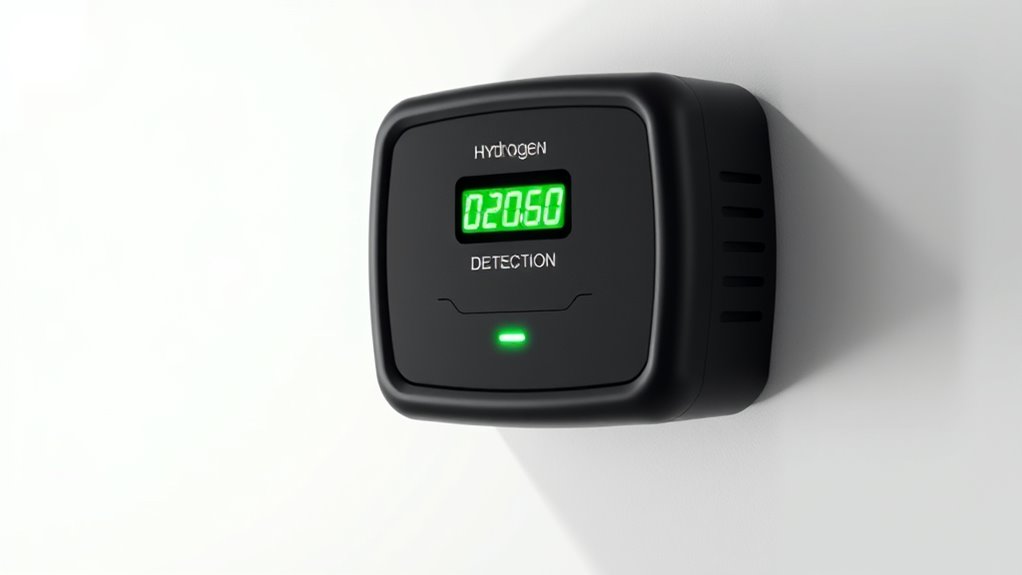
When selecting a wall-mounted hydrogen detector alarm, I consider factors like detection range and accuracy to guarantee it identifies leaks early. I also look at the alarm type’s effectiveness, sensor reliability, and lifespan to make sure it provides consistent safety. Additionally, features like remote calibration and compatible power sources help me choose a device that fits my setup and offers long-term dependability.
Detection Range Accuracy
Choosing a hydrogen detector alarm wall mounted requires careful consideration of its detection range accuracy, as this directly impacts safety and early hazard detection. A wider detection range, like 0-5000ppm, ensures coverage of both low and high hydrogen concentrations, offering comprehensive safety. Accuracy is typically specified as a percentage of the full-scale measurement, with reliable units achieving better than ±5% FS. High-resolution sensors, such as 0.1ppm, enable detection of small hydrogen level changes, essential for early warning. Calibration methods, including auto-calibration and zero calibration, play a critical role in maintaining measurement precision over time. Additionally, signal outputs like 4-20mA and RS485 help transmit accurate data, ensuring consistent and dependable monitoring. Prioritizing these factors helps select a detector with ideal detection range accuracy.
Alarm Type Effectiveness
Have you considered how the environment influences the effectiveness of alarm types in a hydrogen detector? Sound alarms activate within seconds, making them ideal for immediate alerts in open or noisy areas. Light alarms, like flashing LEDs or indicator lights, improve visibility in loud environments or where sound may not be heard. The environment dictates which alarm type is more effective; noisy spaces require visual cues, while quiet or visually obstructed areas benefit from loud sounds. To maximize safety, combining both sound and light alarms offers redundancy, ensuring alerts reach personnel regardless of surroundings. Additionally, adjustable volume and brightness levels are essential for tailoring alerts to specific environments, preventing missed warnings and enhancing overall safety.
Sensor Reliability & Lifespan
Selecting a reliable wall-mounted hydrogen detector alarm hinges considerably on the sensor’s lifespan and stability. Typically, sensors last between 2 to 5 years, influenced by usage and environmental factors. Electrochemical sensors generally outperform catalytic ones in reliability and longevity, offering a longer service life. Regular calibration and maintenance are vital to guarantee the sensor remains accurate and functional over time. Sensors built with high-quality Swiss-imported components tend to be more stable and durable, providing consistent detection. Additionally, the sensor’s response and recovery times are good indicators of its reliability, as quicker responses mean the alarm can detect hydrogen leaks promptly. Prioritizing these aspects helps guarantee the detector maintains high accuracy and dependable performance throughout its operational life.
Remote Calibration Features
Remote calibration features are essential for ensuring your wall-mounted hydrogen detector remains accurate and safe to use. These features allow me to adjust alarm set points and calibrate sensors without opening the device cover, reducing exposure to hazardous gases and increasing safety. Infrared remote controls enable non-intrusive zero and span calibrations, as well as address modifications, simplifying maintenance tasks. Full software auto-calibration automatically fine-tunes sensor baselines based on environmental conditions, maintaining measurement accuracy over time. Zero calibration helps eliminate sensor drift, ensuring reliable detection thresholds. Having remote calibration capabilities means I can perform setup, calibration, and maintenance more quickly, minimizing operational downtime and ensuring continuous, dependable monitoring of hydrogen levels in hazardous environments.
Power Source Compatibility
Choosing the right power source for a wall-mounted hydrogen detector alarm is vital to guarantee continuous and reliable operation. You need to ensure the device is compatible with your available power supply, whether it’s AC mains or battery-powered. Check if it supports standard inputs like 12V, 24V DC, or 110V/220V AC to match your electrical system. Also, consider whether the detector has a rechargeable battery or requires external power, and review its battery life and charging needs. Backup power options are essential for maintaining safety during outages. Finally, verify that the connection methods and voltage requirements align with your existing wiring or infrastructure, ensuring a safe and seamless installation. Proper power compatibility guarantees consistent monitoring without interruptions.
Installation & Maintenance Ease
Installing and maintaining a wall-mounted hydrogen detector alarm becomes much easier when the device features user-friendly interfaces and remote control capabilities. Look for models with remote calibration options, like infrared controls, to simplify setup and ongoing adjustments without opening the unit. Full auto-calibration and zero calibration functions help maintain accuracy with minimal manual effort. Clear signal outputs such as 4-20mA and RS485 make integration and troubleshooting straightforward during maintenance. Devices designed with intuitive interfaces and remote controls for alarm point adjustments or address changes reduce the need for technical expertise on-site. Additionally, choose detectors with durable, explosion-proof enclosures and accessible calibration ports—these features streamline routine inspections and maintenance, saving time and reducing potential errors.
Environmental Suitability
Selecting a hydrogen detector alarm that suits your environment requires careful attention to its environmental suitability. I check the detector’s humidity range to guarantee it can handle conditions like up to 95% RH for humid or industrial settings. Temperature compatibility is vital, too, as extreme temperatures can cause false alarms or sensor failure. I also verify if the housing is explosion-proof or certified for hazardous environments, such as IP65 or Ex d II CT6, to promote safety. The sensor technology, often electrochemical, must perform reliably under specific environmental conditions. Ultimately, I assess whether the detector resists dust, moisture, and chemicals, which can affect long-term accuracy and durability. These factors help me select a detector that remains reliable and effective in my environment.
Frequently Asked Questions
How Often Should Wall-Mounted Hydrogen Detectors Be Calibrated?
You should calibrate wall-mounted hydrogen detectors at least once a year to guarantee they stay accurate. Some manufacturers recommend more frequent calibration, especially in high-use or harsh environments. I always check the device’s manual for specific guidelines, and if I notice any false alarms or irregular readings, I calibrate immediately. Regular calibration keeps your detector reliable and ensures you’re protected against potential leaks.
Are Wall-Mounted Hydrogen Detectors Suitable for Outdoor Use?
I wouldn’t recommend using wall-mounted hydrogen detectors outdoors. For example, I once saw a facility where they tried to place indoor detectors outside, and the sensors kept giving false alarms due to weather conditions. These detectors are typically designed for indoor environments, so factors like rain, wind, and temperature fluctuations can compromise their accuracy. For outdoor safety, specialized weatherproof detectors are necessary to guarantee reliable monitoring.
What Is the Typical Lifespan of a Hydrogen Detector Alarm?
Typically, a hydrogen detector alarm lasts about 3 to 5 years. I recommend checking the manufacturer’s guidelines because lifespan can vary based on usage and environmental conditions. Regular testing and maintenance are essential to guarantee it stays reliable. When it approaches its end, most alarms will give a warning, so I always stay vigilant and replace them promptly to ensure continuous safety.
Can Multiple Detectors Be Integrated Into a Centralized Monitoring System?
Yes, multiple detectors can be integrated into a centralized monitoring system. I’ve seen this work well in larger facilities, where a network connects all alarms to a central hub. This setup allows for real-time alerts, easier maintenance, and extensive safety oversight. Integration typically involves compatible communication protocols like Ethernet or wireless connections, ensuring seamless data flow. It’s a smart way to enhance safety and response efficiency across the entire area.
Do Wall-Mounted Hydrogen Detectors Require Regular Maintenance or Battery Replacement?
They definitely need regular maintenance and battery replacements. Think of it as giving your detector a health check-up to keep it running smoothly. I recommend checking the batteries at least once a year and testing the alarm monthly to confirm it works properly. Cleaning the sensors periodically also helps uphold accuracy. Staying proactive with maintenance will keep your safety system reliable and ready to alert you when it counts most.
Conclusion
Choosing the right wall-mounted hydrogen detector feels like installing a vigilant guardian in your space—always alert, never sleeping. I’ve seen how a quick alarm can prevent a disaster, much like a lighthouse guiding ships safely through fog. Investing in a reliable detector is like planting a sturdy tree that stands firm against storms. Trust me, with the right alarm, you’ll breathe easier knowing you’re protected from unseen hazards lurking in the shadows.





